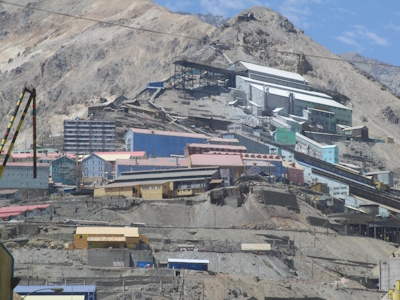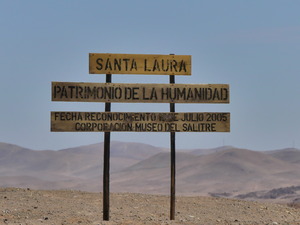Sewell Mining Town

Sewell Mining Town is an example of an early 20th-century company town set up by a foreign company for copper mining.
The site is located in a harsh environment on the slopes of the Andes. Founded in 1905 by the Braden Copper Company, the commercial company built all infrastructure necessary to exploit what was to become the world’s largest underground copper mine. In its heydays, 15,000 people lived here. The remains consist of industrial installations and residential and social buildings.
Community Perspective: early reviewers have put quite an effort into finding out how exactly this site that is managed by a private company can be entered. The most recent review by Timonator (2023) provides the most up-to-date information. Some reviewers describe their visits as “eerie”, with “corridors of doors that are never opened or closed and hide an emptiness behind them”. Be aware that you're not allowed in if you are over 70.


Map of Sewell Mining Town
Load mapCommunity Reviews
Els Slots

Much has been written already about Sewell, and the two most recent reviews by Timonator and Clyde cover the experience well. Reviews from before 2018 show the development of the site over time but do not reflect the current situation anymore as both visitor management and conservation of the buildings have much improved.
Still, I have some practical info:
- First and foremost: the CODELCO company that runs the area only allows access to people between the ages of 7 and 70. You have to state your age when booking – Fundacion Sewell does not check it but the CODELCO security people at the gate might.
- You have to climb a lot of stairs during the tour. If you’re incapable of doing that, the bus trip out there might still be worth it and you can stay near the museum, but you miss out on a lot.
- When you haven’t booked the included lunch, you can eat your own at the cafeteria. They also sell coffee and some snacks (and hotdogs).
- Be prepared for a long and slow day. I took the option to start in Santiago (usually offered on Saturdays), we were requested to assemble at a spot near the Tobalaba metro station at 7.30. We arrived back there at 18.15. The tour is slow-paced and could be made more efficient by for example showing the safety video on the bus instead of the office etc. But overall it was similar to how other Chilean tours are run that I have been on. The tour leadership even was so laissez-faire that I lost the group for half an hour or so (or they lost me!). I waited for them at the museum where all tours end. One of the guides then gave me a private tour of the parts that I had missed including the bowling alley.
And some site trivia:
- The brightly painted colours of the buildings in Sewell were a later addition (in the 1950s?), introduced by a painter who brought the idea from Valparaiso.
- The former Industrial School (now the museum) was built after a modernist design.
Of course, this short review is also an excuse to show photos of two of the most remarkable indoor remains of the recreational culture at Sewell in its heydays: the top one is the swimming pool inside the ‘A’-class (American) social club, the bottom one is the bowling alley which was open to all.
Read more from Els Slots here.
Clyde

I visited this WHS in 2023 as a day trip from Rancagua. I reserved a spot with Fundacion Sewell and communicated with them via whatsapp to make sure I had an English guide and I opted for lunch to be included. I drove to Rancagua from Valparaiso very early in the morning to avoid the rush hour. The ride was very smooth and easy, apart from the thick morning fog in certain stretches. I parked my rental car inside the fence of Fundacion Sewell's Rancagua office and departure point and joined several other visitors (mostly Chilean) on one of the coaches heading toward the Sewell Mining Town. The English speaking group is usually much smaller than the Spanish speaking one and the tour guides are well organised and start the tours from opposite ends. Lunch is a canteen like experience, but the highlight there is not the food but the fact that you literally share the canteen table with some of the workers who still work there and most have family members who have worked there in the past. So it really is a positive experience and personally an unexpected highlight of the tour. I opted for the day tour; the night tour is geared mostly at teenagers and children with a special focus on a Halloween themed experience rather than a cultural tour.
On the coach, I stayed in the front seat with the guide, close to the driver and window, to take photos from the front tintedless window of the wonderful landscape outside (going up I would suggest staying on the right hand side of the bus). Already in Rancagua you'll see the stadium which was once placed in the Sewell Mining Town itself. Then you'll see whole convoys of blue and orange shuttles ferrying workers up and down the mountains to the mining sites and back, as well as long truckloads of copper, the main prized product of the mininig site. The highway is aptly nicknamed as the Copper Road and it was a major upgrade from the railways of the beginning of the 20th century. Thanks to it miners and their families no longer needed to live right in the heart of the mountains in order to work at El Teniente.
Right after viewing Machali in the distance, you'll pass by the Monument to the Mining Family which pays homage to the workers at El Teniente and their families. If there is one thing that characterises the families of Sewell in times gone by, it is the way in which they identify with and feel proud of their particular customs and lifestyle, including the epic nature of their work in the mine. This spirit is still very evident in the miners today as well as one the many patriotic billboards along the Copper Road. Another highlight on the way to Sewell, just before the extinct geyser and the narrow tunnel/bridge there's a high chance of spotting the majestic condor soaring in the skies. I was particularly lucky as there were around six or seven which we spotted going up and down. The driver stops a bit along the way so keep your cameras ready and your eyes peeled. I had missed on the Colca Canyon in Peru a couple of years before so I was very happy with this pleasant surprise.
Next you'll stop at he Maitenes control point which looks rather like a customs or border control point, but it is the entrance to the El Teniente division of Chile's national copper enterprise, Codelco, the world's largest copper producer. On the way back you'll stop again here; an interesting trivia is that randomly drivers (including the ones driving the tour bus) are stopped and have to undergo a series of alert tests to make sure that the drivers aren't too tired, since the never-ending hairpins and VERY narrow tunnels are quite dangerous and require the drivers to be skilled and lucid! If the driver fails, this will set you back 45 minutes each time, and he'll have to repeat it until he passes.
The landscape changes drastically from the lush green of the central valley which then gives way to the native trees so characteristic of the Andes foothills. At 4,920 feet you'll then enter the high Andean steppe, slight south of the Rio de Los Cipreses National Reserve, and then a desert-like volcanic landscape with industrial areas such as Caletones, Tranque Barahona, the Colon Concentrator where 85 % of the ore extracted from the deposit, 130,000 tonnes per day, is crushed, ground, thickened, filtered and dried, Chapa Verde, Adit 71, and finally the Sewell Mining Town some 60 kms away from Rancagua. It had snowed the night before my visit, so the white fresh snow added to the picturesque combined natural/industrial landscape. Once at Sewell, you are now at 2,200 metres (7,200 ft) above sea level (so it is advised to bring a light jacket or cardigan), on the slopes of Cerro Negro, right in the heart of the Andes mountains.
This mining town was founded in 1905 by a group of North Americans and Chileans determined to undertake the challenge of extracting copper in this remote and difficult to access place. It is the birthplace of large scale copper mining in Chile. A constant threat for this mining town are avalanches and/or mudslides. You'll notice a series of secondary metal staircases strangely coming out of the upper windows at the level of the roofs for this reason - avoiding getting snowed in! The main buildings you'll visit during the tour are the Teniente Club (toilet facilities here and at the canteen), Edificio Camarote 35, Edificio 42, Edificio 105, the Palitroque (Bowling) and Swimming Pool, the Church modelled on the Chiloe churches, the playground area with the small cinema, and the main square with the School which now houses the Musuem of Copper Mining. Opposite the entrance is the UNESCO WHS inscription plaque (sometimes hidden by the vendors selling copper jewellery).
The museum is very informative with lots of original stuff from the mining town (similar to some of the furniture in the buildings you visit during the tour). There's also a lift simulation with an informative video on the mining town's past, present and future; now heavily dependent on remotely controlled robots and high-tech. I really liked the room with scale models of the individual buildings showing the several layers used in constructing/restoring the non-cement buildings. At the Teniente Club you'll notice from one of the old photos on the wall that all the buildings weren't painted in the past, so the overall appearance was less colourful and much more like the mining town of Rammelsberg, Germany.
I'm usually not a huge fan of industrial WHS but this one I really enjoyed and the tour is fairly priced and really informative and well organised overall. They need to invest in a paypal account in the future to accept online payments without any expensive bank charges for bank transfers. However, I communicated my details via whatsapp and they allowed me to pay by credit card at their office in Rancagua before the tour started.
Timonator

Thanks to the sharing of information in this community I approached Fundación Sewell in Rancagua to organise a tour. They started again after the pandemic in the beginning of 2023 with a visit roughly each weekend. I approached Angélica who was a very helpful contact and also our tourguide. The tour is in Spanish and costs 33.000 CLP, but luckily a friendly Britisch visitor translated a bit for me and other non- Spanish speakers plus Angélica explained a bit with her German skills. You can not visit Sewell on your own as CODELCO doesn't allow it and it's their territory! I took a bus at 7 in the morning from Santiago to Rancagua and returned with a bus at 5 p.m. to Santiago.
The ride to Sewell from Rancagua is already a highlight in itself. After crossing the checkpoint from CODELCO, the national copper company, there are great views of the huge copper mine La Tenienda and its industrial sites along the road. Especially because it's not possible to visit the huge Chuquicamata mine further north anymore it was interesting to get an idea where huge amounts of copper are coming from.
The tour starts after approaching Sewell Mining Town more or less at the end of road. Already before explainations in Spanish during the ride are delivered in the bus. I have to say that I got a bit of a headache with the 2000m + elevation that we passed by in the morning despite drinking a lot.
During the site visit in Sewell we were able to get inside the event hall of town, two living houses, the bowling alley, the former police station with a huge painting of the 1945 mine disaster and the church. Also we had 20 minutes in the copper museum which includes a mine simulation in the basement.
The site gives interesting insides into the life of American managers that ran this copper mine in the first part of the 20th century and the Chileans that worked in the mine. Also the landscape of the copper mine is fascinating.
Read more from Timonator here.
Michael anak Kenyalang
There are less information of how to get there, so I'm sharing the one I did and hope it helps anyone who intend to go. First, there's no direct bus from Santiago and you're permitted to get in on your one car. The easiest way is to book a tour with Fundación Sewell online (fundacionsewell@gmail.com). This is a non profit organization that's related to Sewell and it's way cheaper than those tours offered online.
But then you have to know that you have to go to the meeting point. Here's what I did. Take a bus from Santiago and specified that you have to drop at Terminal O'Higgins Rancagua (cos there are TWO terminals). Then walk from the terminal to the meeting point at their office, it's about 10-15 mins walk if you googled the route. After the safety video we departed with tourist bus around 10am. The journey takes around 1 hour.
I was lucky to have a good English speaking guide Anitza. Though she explained most of the time in Spanish to the Chilenos but she would explain to me in English for things that I don't understand. We started at the El Teniente Club with a video regarding history of Sewell, then the guide explained a bit of the surrounding and itinerary.
We went to see the living quarters of the miners. At lunch time you can have the pre booked lunch or your can bring your own and have it at the miners restaurant. I was lucky to meet some miners and took photo with them at the restaurant when they came for lunch. After lunch we visited the first bowling alley in Chile where the miners used to have competition everyday and also you can ask you guide for the spooky ghost story about this place. Then we went to the little church and finally the museum.
I strongly recommend the museum. It housed one of the most complete copper related items in the world. The ground floor has some minerals found close to the copper mine and a gift shop. The first floor is more to the tools used in copper mining and also some daily life of Sewell mining town in the past. Then the second floor has a vast collection of copper made items and artifacts from around the world. It will change your mind of how people from around the world use copper from past to present.
And finally after the museum, we were lucky to have one hour to play with the snow. It's recommend to come during winter as it's covered with snow everywhere. You can throw a snowball or built a snowman. It was really fun. But make sure you bring waterproof shoes and windproof jacket as it tend to be cold outdoor.
Michael Novins

In October 2017, I made a long day trip from Santiago to Sewell Mining Town. Weekend trips organized by VTS (http://www.vts.cl) depart at 8:30 am from the international coffee chain just outside Baquedano metro station, one of the major transfer stations, and return to the same location around 7:30 pm, nearly 11 hours later.
If you take the trip on a Sunday, as I did, bear in mind that the tour does not stop for lunch (included) until after the visit, around 4:30pm, and that most local stores in Santiago don't open on Sundays until after the departure time, so you won't be able to purchase breakfast or snacks until the first stop, more than an hour after departure, outside a supermarket in Rancagua, where other visitors join the tour.
Michael Turtle

It's not easy to get here but it's definitely worth it. I organised a tour from Rancagua which went to the town once a week. There are also apparently tours you can do from Santiago.
It's an incredible place to be in, with everything abandoned. There’s an old theatre that is empty but for the memories of the nights that the workers would spend here to find relief from the loneliness of their lives. Dormitory buildings have corridors of doors that are never opened or closed and hide an emptiness behind them. The wide and steep staircases between the buildings lead to nowhere.
Read more from Michael Turtle here.
Tessa
We went to Sewell in 2006 and it was quite interesting the buildings were very old and you could almost sense the people that used to live there, were still around it was very eerie bit we went into the actual mine and it was amazing especially seeing the giant crystal quartz.Amazing!
We wemt on a tour with a tour guide and he was very informative and answered every question we asked him.It was exciting getting dressed up as a miner.Afterwards we managed to have lunch with all the other miners in the dining room.It is also a nice drive there and back.Lovely.I would highly reccommend this tour to anyone that has an interest in historical towns and sites and also anyone that has a desire to see how a mining actually works and operates.
Werner Huber
We visited Sewell in February 2008 encountering some difficulties. There is a homepage (www.sewell.cl) for sewell by CODELCO, the state owned company, which runs several mines, amongs them El Teniente, to which the mining town of Sewell belongs.
This page is of limited use as rather than telling you how to get there, what it costs, etc, it refers to a company called VLT which has the monopoply of taking people there. This is done either by bus on Fro, Sat and Sun for approx 45 USD pP or on all other days as private tour for 144 USD pP.
The committment that CODELCO seems to have with UNESCO is that Sewell as a seperate entity from the mine has to become profitable entity from its tourism engagements within a rather short timeline, otherwise CODELCO might step out. We have been told, that the number of tourist to come to Sewell for the reasons UNESCO declared it a world heritage is already declining after an initial peak, people are more interested in the actual mine rather than in an aboandoned mining town.
Finally one has to understand that you see today only a fragment of the initial mining town, large parts, in particular the part where the american settlements were has been pulled down when the town had to be abandoned due to pollution problems.
The restauration efforts which happened so far are rather disappointing, if they continue at that speed, the whole thing is gone within a few years.
I have to stress however, that despite all the issues above it is absolutely worth seing and we had a very good and comprehensive tour which we much apprecheated.
Visit it as long as it exits.
UNESCO should be much more rigid with states aor companies like CODELCO and ask for a deeper comittments and sould pu the place on the endangered list immediately.
Site Info
Site History
2006 Inscribed
Site Links
Connections
The site has 21 connections
Art and Architecture
Constructions
Damaged
Geography
Human Activity
Timeline
Trivia
Visiting conditions
WHS Names
World Heritage Process
Visitors
50 Community Members have visited.
The Plaque
 (photo by Clyde)
(photo by Clyde)